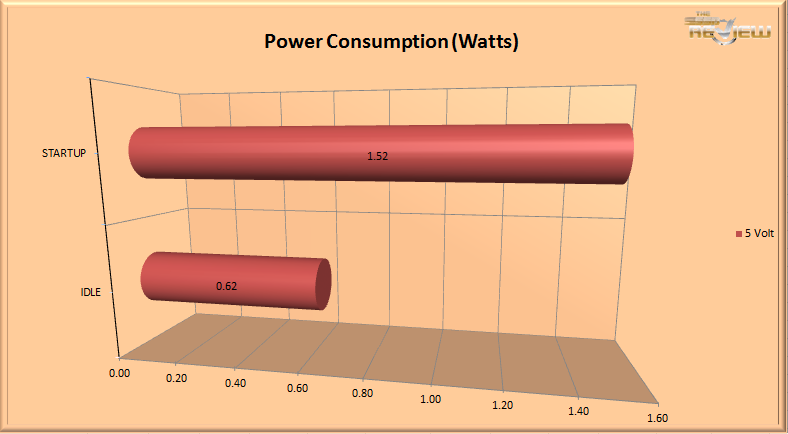POWER AND HEAT
Power consumption is always a big deal in the server environment for several reasons. Providing power, and redundancy for that power, is a very expensive proposition and the highest ongoing expense for any enterprise application. Power consumption also equates to heat production, which in turn requires more power to effectively dissipate. A double edged sword, power and heat feed upon each other, generating a tremendous concern for system administrators.
SSDs in general fare well in this area, with some being more effective than others. Two key measurements are most often mentioned when discussing the power requirements of any Storage device, that being idle and start-up power consumption. Idle highlights the theoretical minimum power draw, while start-up represents the other end of that spectrum.
We measure the peak of the start-up power, even though this can be largely irrelevant of the long term power consumption of the device. While still a relevant metric, this harkens back to the HDD, where large start-up voltages can overpower Power Supply Units (PSU) when massive amounts of drives are brought online simultaneously.
Two hundred HDDs coming on at the same time can fry many a power supply, as the PSUs are right sized for the loads that they are designed to handle during operation. As always, everything in the data center is tirelessly optimized, so drives have to be brought online in small groups so that the perfectly-sized power supplies, which operate at high efficiency ratings, can handle them. SSDs use much lower thresholds, so the measurement isnt nearly as relevant other than to highlight the theoretical maximums.
 The P400e performs shockingly well in this metric. With a start-up that draws only 1.52 Watts, you would be hard pressed to find a lower start-up value outside of other Micron offerings. Sipping only .62 Watts at idle is also fantastic. Being entry level drives, these SSDs will be subjected to exponentially larger amounts of idle time than typical SSDs. In boot applications where the SSD is used only to run the host operating system, low power sipping values such as these are tremendously good.
The P400e performs shockingly well in this metric. With a start-up that draws only 1.52 Watts, you would be hard pressed to find a lower start-up value outside of other Micron offerings. Sipping only .62 Watts at idle is also fantastic. Being entry level drives, these SSDs will be subjected to exponentially larger amounts of idle time than typical SSDs. In boot applications where the SSD is used only to run the host operating system, low power sipping values such as these are tremendously good.
As we move into the expanded power testing under various loads below, one can observe that across the board the power consumption of the P400e is spectacularly low. Bear in mind that these impressive numbers are while the SSD is under a high load at a QD of 32.
 As heat is a huge concern in the majority of enterprise applications, we have measured the heat output as well during our testing. Heat must be mitigated through various means of cooling inside the data center, so it can produce huge incremental costs. All heat measurements we have done are without any fan-driven air flow, so with any type of airflow the device will run much cooler than shown. The important measurement here is the amount of heat generated, and again the measurements were compiled during QD32 loadings in Steady State conditions.
As heat is a huge concern in the majority of enterprise applications, we have measured the heat output as well during our testing. Heat must be mitigated through various means of cooling inside the data center, so it can produce huge incremental costs. All heat measurements we have done are without any fan-driven air flow, so with any type of airflow the device will run much cooler than shown. The important measurement here is the amount of heat generated, and again the measurements were compiled during QD32 loadings in Steady State conditions.
The IOPS per Watt measurements below take the performance of the SSD at QD32 compared to the amount of wattage that we recorded being consumed. Here the P400e again performs very admirably, with the low power consumption of the SSD allowing these drives to shine in this respect. From a power per watt perspective we recorded 24,139 for 4k Random Read.
With Random Writes the drive managed to achieve 23,860 IOPS to Watts for FOB performance with a low level of fill, and 4,803 IOPS/Watt for 100% capacity utilization and full span writes. With 20% OP the drive managed to pull that IOPS to Watt performance up to 5,401.
 The SSD Review The Worlds Dedicated SSD Education and Review Resource |
The SSD Review The Worlds Dedicated SSD Education and Review Resource | 
$100 for a 50GB drive is not too shabby IMHO. There are a lot of applications which could use something another rung up the ladder from the Micron M400 at a decent price.
To be quite honest the price of this ssd is simply outstanding for its feature set. I feel that it is underpriced but dont tell Micron 🙂
https://goo.gl/urqzK
Had two fail. 2 out of 2